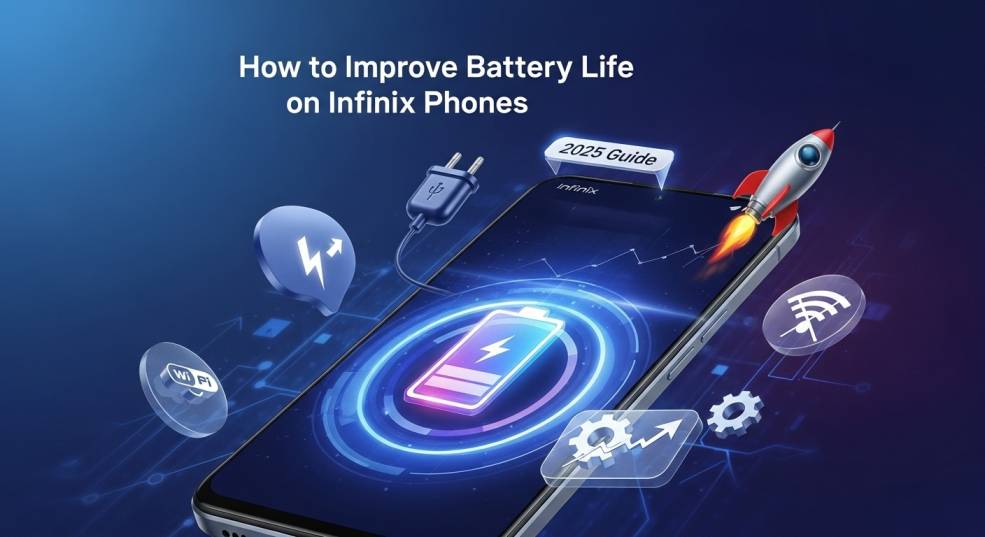Running out of battery right when it’s needed most is the worst feeling ever, especially during classes, games, or long trips. The good news is that Infinix phones in 2025 have tons of smart features like Battery Saver, Battery Lab, and Android’s Adaptive Battery that can seriously boost screen‑on time without ruining performance. This guide shows easy steps anyone can follow, with exact settings to tweak for longer battery life on any Infinix running recent XOS versions.

Turn On Battery Saver and Ultra Modes
Battery Saver lowers power use by limiting background activity, cutting animations, and reducing some syncing, which directly stretches remaining charge for hours in emergencies. On Infinix, open Settings > Battery & Power Saving, then toggle Battery Saver; many models also include Ultra or Super Power Saving modes that restrict the phone to essential apps for extra hours when under 15–20%.
Use Android Adaptive Battery and Brightness
Adaptive Battery learns which apps are rarely used and quietly limits their background activity so they stop draining power when idle, improving overall endurance after a few days of learning. Turn it on in Settings > Battery > Adaptive preferences > Use Adaptive Battery, and consider enabling Adaptive Brightness so the phone auto‑adjusts the screen intelligently across the day.
Optimize Background Apps and Notifications
Some apps, like social, video, and shopping, keep waking the phone; manually optimize them by going to Settings > Apps > Select app > Battery and choosing “Restricted” for heavy drainers while keeping messaging apps “Optimized”. Also, trim notifications for apps that send too many alerts, since every wake‑up plus vibration or sound costs battery over time.
Try XOS Battery Lab and Power Marathon
Infinix’s XOS includes Battery Lab tools that use AI to optimize consumption, add charging modes, and enable power‑saving profiles tuned for longer life on supported devices. Look for Battery Lab or Power Marathon in Settings; newer XOS 15 builds add smarter charging modes and tweaks that balance performance with endurance when needed.
Network and Location Tweaks Matter
If the signal is weak, the modem works harder and drains faster, so lock to a stable network or switch to 3G/2G temporarily in low‑coverage areas to save power. Turn off GPS when it’s not needed and avoid constant high‑accuracy location, because radios and scanning consume noticeable battery over the day.
Display, Refresh Rate, and Brightness
Displays usually take the biggest battery slice, so reducing brightness to around 30–50% can save a lot without hurting visibility indoors. If the model supports high refresh rate, switching to “Auto” or 60 Hz helps reduce drain while still feeling smooth enough for most apps and scrolling sessions.
Charging Habits and Battery Health
Fast charging is fine, but keeping the phone topped at 100% all night isn’t ideal; features like “Protect Battery” on some Android builds limit max charge to around 80–85% to slow aging. If available in XOS/Android settings, enable smart/adaptive charging so the phone learns when it’s usually plugged in and finishes charging right before wake‑up time.
Quick Wins for Busy Days 🚀
Enable Ultra/Super Power Saving when under 10–15% to squeeze out calls and messages for a few extra hours.
Lower brightness and disable auto‑download of videos in messaging apps to reduce background downloads.
Close heavy apps from Recents when leaving them running for long periods, especially video and social apps.
Comparison Table: Battery Boosting Options
| Option | What it does | When to use | Expected gain |
|---|---|---|---|
| Battery Saver | Limits background/sync and performance | Under 30% or long day out | Adds hours depending on use |
| Ultra/Super Power Saving | Essential apps only, grayscale UI | Emergencies below 15–20% | 3–6 extra hours possible |
| Adaptive Battery | Learns and limits rare apps | Always on | Noticeable after a few days |
| Battery Lab/Power Marathon | XOS AI optimizations and modes | Daily or heavy use days | Smarter balance of power and speed |
| Adaptive Brightness | Auto adjusts screen levels | Indoors/outdoors mix | Less manual brightness waste |
Step‑by‑Step Setup Checklist
Turn on Adaptive Battery and Adaptive Brightness in Battery settings and Display settings, respectively.
Set Battery Saver to auto‑activate at 20% and keep Ultra/Super mode handy for emergencies.
In Apps > Battery, restrict background for the top three draining apps identified in battery usage charts.
Use Battery Lab/Power Marathon profile on days with long travel or gaming to reduce surprise drain.
Cut location scanning and Bluetooth/Wi‑Fi scanning when not needed to reduce background wake‑ups.
FAQs ❓
Q1: Does Adaptive Battery reduce performance a lot?
A: It mostly limits background activity for rarely used apps, with only subtle performance impact that most people won’t notice during normal use.
Q2: How long until Adaptive Battery shows results?
A: Expect meaningful improvements after several days, since it needs time to learn which apps to slow down in the background.
Q3: Is Ultra Power Saving safe to use daily?
A: It’s best for emergencies because it restricts features; for daily use, keep Battery Saver or Balanced modes on instead.
Q4: Do Infinix phones have special battery features in 2025?
A: Many models running newer XOS builds include Battery Lab and Power Marathon, plus updated charging modes that optimize endurance and health.
Q5: What single change helps most on any phone?
A: Enabling Adaptive Battery and trimming background/notification activity on the worst offenders typically gives the biggest day‑to‑day gains
With these steps, an Infinix can last longer through classes, streaming, and socials without constant charging, and the phone will keep getting smarter about saving power the more it’s used.

